Experimental Study on the Effects of Hydrogen Injection Strategy on the Combustion and Emissions of a Hydrogen/Gasoline Dual Fuel SI Engine under Lean Burn Condition
Abstract
:1. Introduction
2. Materials and Methods
3. Results and Discussions
4. Conclusions
- The lean-burn performance could be improved with hydrogen addition. In this study, the lean burn limit with the NHMD was the excess air ratio of 1.5, while with 20% hydrogen addition, it was the excess air ratio of 2.8;
- With the increase in the excess air ratio, the brake thermal efficiency of the engine first increased and then decreased. Moreover, hydrogen addition improved the brake thermal efficiency. With the NHMD, the maximum brake thermal efficiency (23.83%) appeared at the excess air ratio of 1.2, while with the PPHMD, the maximum brake thermal efficiency increased to 26.86% at the excess air ratio of 1.5;
- With the increase in the excess air ratio, the best HMD changed from the PPHMD to the SHMD. Since the engine ignition became the key factor under lean-burn conditions, the hydrogen concentration around the spark plug was the highest with the SHMD;
- The COV of the engine increased with the increase in the excess air ratio, since the engine ignition became unstable and the engine combustion was slower under lean-burn conditions. The COV with the NHMD was higher than that with hydrogen addition, which was because hydrogen addition improved the ignition and combustion stability;
- The HC emissions first decreased and then increased with the increase in the excess air ratio because the increase in oxygen concentration led to the deterioration of combustion. The HC emissions were the highest with the NHMD and the lowest with the PHMD. The hydrogen concentration affected the HC emissions significantly. The HC emissions with the PHMD were, on average, 4.01% lower than with the PPHMD, 14.07% lower than with the SHMD and 51.96% lower than with the NHMD;
- The NOx emissions first increased and then decreased with the increase in the excess air ratio since the engine temperature was reduced and the oxygen concentration increased. When the excess air ratio was greater than 2.0, there were almost no NOx emissions. The NOx emissions were the lowest with the NHMD and the highest with the SHMD. The NOx emissions with the NHMD were, on average, 42.22% lower than with the PHMD, 45.08% lower than with the PPHMD and 47.21% lower than that with SHMD.
Author Contributions
Funding
Institutional Review Board Statement
Informed Consent Statement
Data Availability Statement
Conflicts of Interest
Abbreviations
| Nomenclature | |
| φ | energy fraction of hydrogen |
| QH2 | the energy of hydrogen (J) |
| Qgasoline | the energy of gasoline (J) |
| Abbreviation | |
| SI | Spark Ignition |
| HMD | Hydrogen Mixture Distribution |
| SHMD | Stratified Hydrogen Mixture Distribution |
| PHMD | Premixed Hydrogen Mixture Distribution |
| PPHMD | Partially Premixed Hydrogen Mixture Distribution |
| NHMD | No Hydrogen Mixture Distribution |
| CO | Carbon Monoxide |
| HC | Hydrocarbon |
| NOx | Nitrogen Oxides |
| RCCI | Reactivity Controlled Compression Ignition |
| COV | Coefficient of Variation |
| HDI | Hydrogen Direct Injection |
| SHDI | Split Hydrogen Direct Injection |
| EGR | Exhaust Gas Recirculation |
| CA | Crank Angle |
| BTDC | before Top Dead Center |
References
- Alhuyi Nazari, M.; Fahim Alavi, M.; Salem, M.; Assad, M.E.H. Utilization of hydrogen in gas turbines: A comprehensive review. Int. J. Low-Carbon Technol. 2022, 17, 513–519. [Google Scholar] [CrossRef]
- Yusaf, T.; Laimon, M.; Alrefae, W.; Kadirgama, K.; Dhahad, H.A.; Ramasamy, D.; Kamarulzaman, M.K.; Yousif, B. Hydrogen energy demand growth prediction and assessment (2021–2050) using a system thinking and system dynamics approach. Appl. Sci. 2022, 12, 781. [Google Scholar] [CrossRef]
- Yildiz, A.; Özel, M.A. A comparative study of energy consumption and recovery of autonomous fuel-cell hydrogen–electric vehicles using different powertrains based on regenerative braking and electronic stability control system. Appl. Sci. 2021, 11, 2515. [Google Scholar] [CrossRef]
- Ji, C.; Wang, S.; Bo, Z.; Liu, X. Emissions performance of a hybrid hydrogen–gasoline engine-powered passenger car under the New European Driving Cycle. Fuel 2013, 106, 873–875. [Google Scholar] [CrossRef]
- Saravanan, N.; Nagarajan, G. An experimental investigation of hydrogen-enriched air induction in a diesel engine system. Int. J. Hydrogen Energy 2008, 33, 1769–1775. [Google Scholar] [CrossRef]
- Acikgoz, B.; Celik, C.; Soyhan, H.S.; Gokalp, B.; Karabag, B. Emission characteristics of an hydrogen–CH4, fuelled spark ignition engine. Fuel 2015, 159, 298–307. [Google Scholar] [CrossRef]
- Yip, H.L.; Srna, A.; Yuen, A.C.Y.; Kook, S.; Taylor, R.A.; Yeoh, G.H.; Medwell, P.R.; Chan, Q.N. A review of hydrogen direct injection for internal combustion engines: Towards carbon-free combustion. Appl. Sci. 2019, 9, 4842. [Google Scholar] [CrossRef] [Green Version]
- Bao, L.Z.; Sun, B.G.; Luo, Q.H.; Li, J.C.; Qian, D.C.; Ma, H.Y.; Guo, Y.J. Development of a turbocharged direct-injection hydrogen engine to achieve clean, efficient, and high-power performance. Fuel 2022, 324, 124713. [Google Scholar] [CrossRef]
- Bao, L.; Sun, B.; Luo, Q. Experimental investigation of the achieving methods and the working characteristics of a near-zero NOx emission turbocharged direct-injection hydrogen engine. Fuel 2022, 319, 123746. [Google Scholar] [CrossRef]
- Bao, L.; Sun, B.; Luo, Q. Optimal control strategy of the turbocharged direct-injection hydrogen engine to achieve near-zero emissions with large power and high brake thermal efficiency. Fuel 2022, 325, 124913. [Google Scholar] [CrossRef]
- Takagi, Y.; Oikawa, M.; Sato, R.; Kojiya, Y.; Mihara, Y. Near-zero emissions with high thermal efficiency realized by optimizing jet plume location relative to combustion chamber wall, jet geometry and injection timing in a direct-injection hydrogen engine. Int. J. Hydrogen Energy 2019, 44, 9456–9465. [Google Scholar] [CrossRef]
- Park, C.; Kim, Y.; Choi, Y.; Lee, J.; Lim, B. The effect of engine speed and cylinder-to-cylinder variations on backfire in a hydrogen-fueled internal combustion engine. Int. J. Hydrogen Energy 2019, 44, 22223–22230. [Google Scholar] [CrossRef]
- Nguyen, D.; Choi, Y.; Park, C.; Kim, Y.; Lee, J. Effect of supercharger system on power enhancement of hydrogen-fueled spark-ignition engine under low-load condition. Int. J. Hydrogen Energy 2021, 46, 6928–6936. [Google Scholar] [CrossRef]
- Gürbüz, H.; Akay, S.H. Evaluating the effects of boosting intake-air pressure on the performance and environmental-economic indicators in a hydrogen-fueled SI engine. Int. J. Hydrogen Energy 2021, 46, 28801–28810. [Google Scholar] [CrossRef]
- Gao, J.; Wang, X.; Song, P.; Tian, G.; Ma, C. Review of the backfire occurrences and control strategies for port hydrogen injection internal combustion engines. Fuel 2022, 307, 121553. [Google Scholar] [CrossRef]
- Kamil, M.; Rahman, M.M. Performance prediction of spark-ignition engine running on gasoline-hydrogen and methane-hydrogen blends. Appl. Energy 2015, 158, 556–567. [Google Scholar] [CrossRef]
- Tang, C.; Zhang, Y.; Huang, Z. Progress in combustion investigations of hydrogen enriched hydrocarbons. Renew. Sustain. Energy Rev. 2014, 30, 195–216. [Google Scholar] [CrossRef]
- Babayev, R.; Andersson, A.; Dalmau, A.S.; Im, H.G.; Johansson, B. Computational comparison of the conventional diesel and hydrogen direct-injection compression-ignition combustion engines. Fuel 2022, 307, 121909. [Google Scholar] [CrossRef]
- Tutak, W.; Grab-Rogaliński, K.; Jamrozik, A. Combustion and emission characteristics of a biodiesel-hydrogen dual-fuel engine. Appl. Sci. 2020, 10, 1082. [Google Scholar] [CrossRef] [Green Version]
- Kanth, S.; Ananad, T.; Debbarma, S.; Das, B. Effect of fuel opening injection pressure and injection timing of hydrogen enriched rice bran biodiesel fuelled in CI engine. Int. J. Hydrogen Energy 2021, 46, 28789–28800. [Google Scholar] [CrossRef]
- Kokabi, H.; Najafi, M.; Jazayeri, S.A.; Jahanian, O. Hydrogen and propane implications for reactivity controlled compression ignition combustion engine running on landfill gas and diesel fuel. Int. J. Hydrogen Energy 2021, 46, 31903–31915. [Google Scholar] [CrossRef]
- Liu, X.; Srna, A.; Yip, H.L.; Kook, S.; Chan, Q.N.; Evatt, R. Performance and emissions of hydrogen-diesel dual direct injection (H2DDI) in a single-cylinder compression-ignition engine. Int. J. Hydrogen Energy 2021, 46, 1302–1314. [Google Scholar] [CrossRef]
- Pan, K.; Wallace, J.S. Computational studies of hydrogen post-injection in direct-injection natural gas engines. Fuel 2022, 323, 124226. [Google Scholar] [CrossRef]
- Chen, L.; Zhang, X.; Zhang, R.; Li, J.; Pan, J.; Wei, H. Cycle-resolved visualization of lubricant-induced abnormal combustion in an optical natural gas/hydrogen engine. Fuel 2022, 321, 124053. [Google Scholar] [CrossRef]
- Sun, X.; Liu, H.; Duan, X.; Guo, H.; Li, Y.; Qiao, J.; Liu, Q.; Liu, J. Effect of hydrogen enrichment on the flame propagation, emissions formation and energy balance of the natural gas spark ignition engine. Fuel 2022, 307, 121843. [Google Scholar] [CrossRef]
- Xu, L.; Sun, X.; Ku, C.; Liu, J.; Lai, M.C.; Duan, X. Effects of control strategies for mixture activity and chemical reaction pathway coupled with exhaust gas recirculation on the performance of hydrogen-enriched natural-gas fueled spark ignition engine. Fuel 2022, 322, 124153. [Google Scholar] [CrossRef]
- Sen, A.K.; Wang, J.; Huang, Z. Investigating the effect of hydrogen addition on cyclic variability in a natural gas spark ignition engine: Wavelet multire solution analysis. Appl. Energy 2011, 88, 4860–4866. [Google Scholar] [CrossRef]
- Huang, Z.; Zhang, Y.; Zeng, K.; Liu, B.; Wang, Q.; Jiang, D. Measurements of laminar burning velocities for natural gas-hydrogen-air mixtures. Combust. Flame 2006, 146, 302–311. [Google Scholar] [CrossRef]
- Rao, A.; Wu, Z.; Mehra, R.K.; Duan, H.; Ma, F. Effect of hydrogen addition on combustion, performance and emission of stoichiometric compressed natural gas fueled internal combustion engine along with exhaust gas recirculation at low, half and high load conditions. Fuel 2021, 304, 121358. [Google Scholar] [CrossRef]
- Hu, E.; Huang, Z.; He, J.; Zheng, J.; Mian, H. Measurements of laminar burning velocities and onset of cellular instabilities of methane–hydrogen–air flames at elevated pressures and temperatures. Int. J. Hydrogen Energy 2009, 34, 5574–5584. [Google Scholar] [CrossRef]
- Zheng, J.; Hu, E.; Huang, Z.; Ning, D.; Wang, J. Combustion and emission characteristics of a spray guided direct-injection spark-ignition engine fueled with natural gas-hydrogen blends. Int. J. Hydrogen Energy 2011, 36, 11155–11163. [Google Scholar] [CrossRef]
- Ji, C.; Wang, S.; Zhang, B. Effect of spark timing on the performance of a hybrid hydrogen–gasoline engine at lean conditions. Int. J. Hydrogen Energy 2010, 35, 2203–2212. [Google Scholar] [CrossRef]
- Hao, L.; Xu, X.; Guo, X.; Ji, C.; Wang, X.; Tan, J.; Ge, Y. Investigation of cold-start emission control strategy for a bi-fuel hydrogen/gasoline engine. Int. J. Hydrogen Energy 2016, 41, 18273–18281. [Google Scholar] [CrossRef]
- Wang, S.; Ji, C.; Zhang, M.; Bo, Z. Reducing the idle speed of a spark-ignited gasoline engine with hydrogen addition. Int. J. Hydrogen Energy 2010, 35, 10580–10588. [Google Scholar] [CrossRef]
- He, F.; Li, S.; Yu, X.; Du, Y.; Zuo, X.; Wei, D.; Sun, P.; He, L. Comparison study and synthetic evaluation of combined injection in a spark ignition engine with hydrogen-blended at lean burn condition. Energy 2018, 157, 1053–1062. [Google Scholar] [CrossRef]
- Yu, X.; Zuo, X.; Wu, H.; Du, Y.; Sun, Y.; Wang, Y. Study on combustion and emission characteristics of a combined injection engine with hydrogen direct-injection. Energ Fuel 2017, 31, 5554–5560. [Google Scholar] [CrossRef]
- Shi, W.; Yu, X.; Zhang, H.; Li, H. Effect of spark timing on combustion and emissions of a hydrogen direct injection stratified gasoline engine. Int. J. Hydrogen Energy 2016, 42, 5619–5626. [Google Scholar] [CrossRef]
- Yao, S.; Yu, X.; Wei, D.; Tang, Y. Effects of hydrogen direct injection on engine stability and optimization of control parameters for a combined injection engine. Int. J. Hydrogen Energy 2018, 43, 6723–6733. [Google Scholar]
- Yu, X.; Wu, H.; Du, Y.; Yang, T.; Niu, R. Research on cycle-by-cycle variations of an SI engine with hydrogen direct injection under lean burn conditions. Appl. Therm. Eng. 2016, 109, 569–581. [Google Scholar] [CrossRef]
- Du, Y.; Yu, X.; Wang, J.; Wu, H.; Dong, W.; Gu, J. Research on combustion and emission characteristics of a lean burn gasoline engine with hydrogen direct-injection. Int. J. Hydrogen Energy 2016, 41, 3240–3248. [Google Scholar] [CrossRef]
- Niu, R.; Yu, X.; Du, Y.; Xie, H.; Wu, H.; Sun, Y. Effect of hydrogen proportion on lean burn performance of a dual fuel SI engine using hydrogen direct-injection. Fuel 2016, 186, 792–799. [Google Scholar] [CrossRef]
- Yao, S.; Yu, X.; Jiang, L. Effects of direct hydrogen injection on particle number emissions from a lean burn gasoline engine. Int. J. Hydrogen Energy 2016, 41, 18631–18640. [Google Scholar]
- Du, Y.; Yu, X.; Liu, L.; Li, R.; Zuo, X.; Sun, Y. Effect of addition of hydrogen and exhaust gas recirculation on characteristics of hydrogen gasoline engine. Int. J. Hydrogen Energy 2017, 42, 8288–8298. [Google Scholar] [CrossRef]
- Salek, F.; Babaie, M.; Hosseini, S.V. Multi-objective optimization of the engine performance and emissions for a hydrogen/gasoline dual-fuel engine equipped with the port water injection system. Int. J. Hydrogen Energy 2021, 46, 10535–10547. [Google Scholar] [CrossRef]
- Qian, L.; Wan, J.; Qian, Y.; Sun, Y.; Zhuang, Y. Experimental investigation of water injection and spark timing effects on combustion and emissions of a hybrid hydrogen-gasoline engine. Fuel 2022, 322, 124051. [Google Scholar] [CrossRef]
- Yu, X.; Li, G.; Du, Y.; Guo, Z.; Li, Y. A comparative study on effects of homogeneous or stratified hydrogen on combustion and emissions of a gasoline/hydrogen SI engine. Int. J. Hydrogen Energy 2019, 44, 25974–25984. [Google Scholar] [CrossRef]
- Li, G.; Yu, X.; Shi, W.; Yao, C.; Wang, S.; Shen, Q. Effects of split injection proportion and the second injection timings on combustion and emissions of a dual fuel SI engine with split hydrogen direct injection. Int. J. Hydrogen Energy 2019, 44, 11194–11204. [Google Scholar] [CrossRef]
- Yu, X.; Li, G.; Dong, W.; Sheng, Z.; Guo, Z.; Li, Y.; Li, D.; Zhao, Z. Numerical study on effects of hydrogen direct injection on hydrogen mixture distribution, combustion and emissions of a gasoline/hydrogen SI engine under lean burn condition. Int. J. Hydrogen Energy 2020, 45, 2341–2350. [Google Scholar] [CrossRef]
- Li, G.; Yu, X.; Jin, Z.; Shang, Z.; Li, Y.; Li, D.; Zhao, Z. Study on effects of split injection proportion on hydrogen mixture distribution, combustion and emissions of a gasoline/hydrogen SI engine with split hydrogen direct injection under lean burn condition. Fuel 2020, 270, 117488. [Google Scholar] [CrossRef]
- Li, G.; Yu, X.; Sun, P.; Li, D. Study on the Effect of Second Injection Timing on the Engine Performances of a Gasoline/Hydrogen SI Engine with Split Hydrogen Direct Injecting. Energies 2020, 13, 5223. [Google Scholar] [CrossRef]
- Pan, S.; Wang, J.; Huang, Z. Effects of hydrogen injection strategy on the hydrogen mixture distribution and combustion of a gasoline/hydrogen SI engine under lean burn condition. Int. J. Hydrogen Energy 2022, 47, 24069–24079. [Google Scholar] [CrossRef]
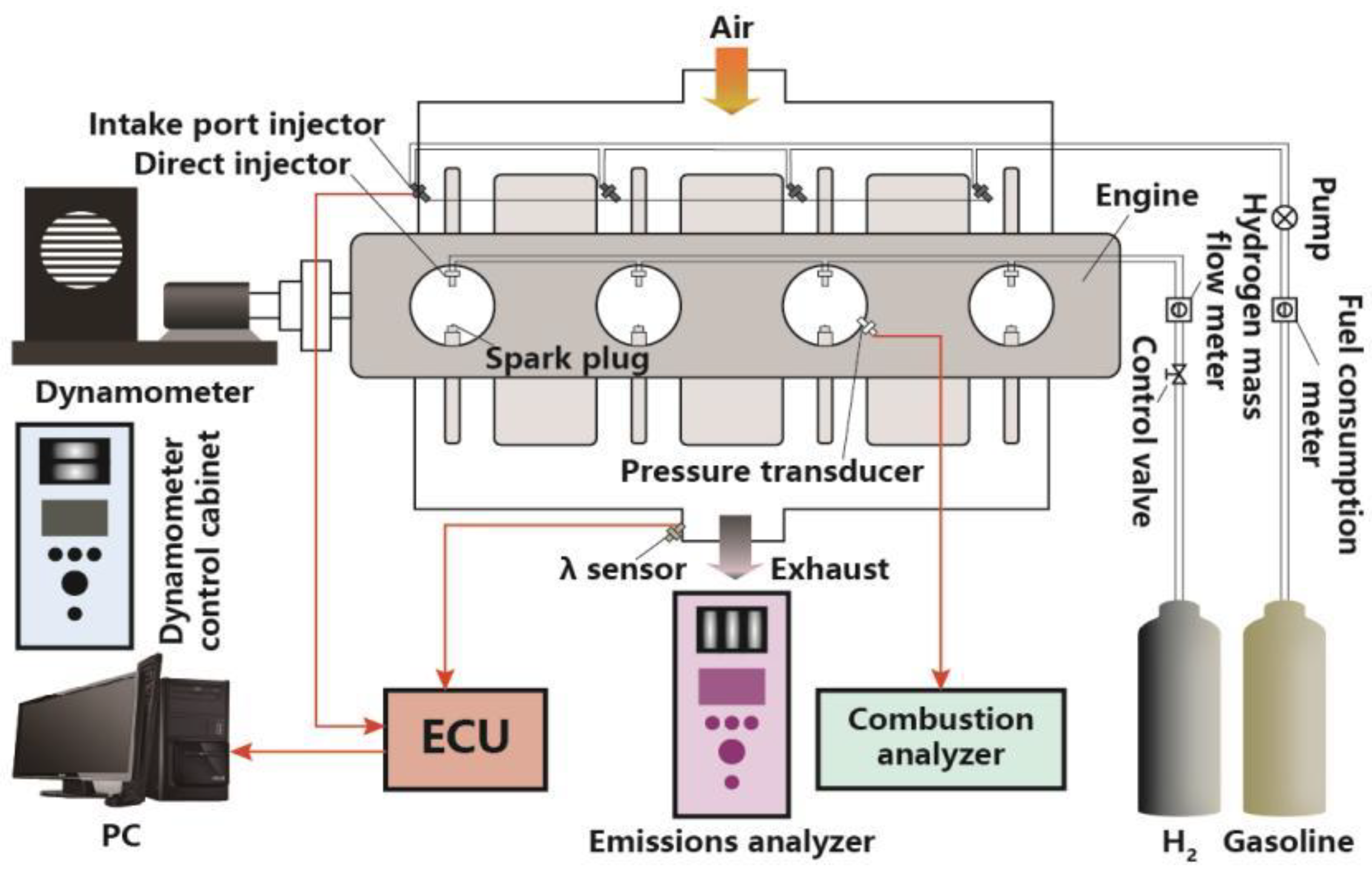
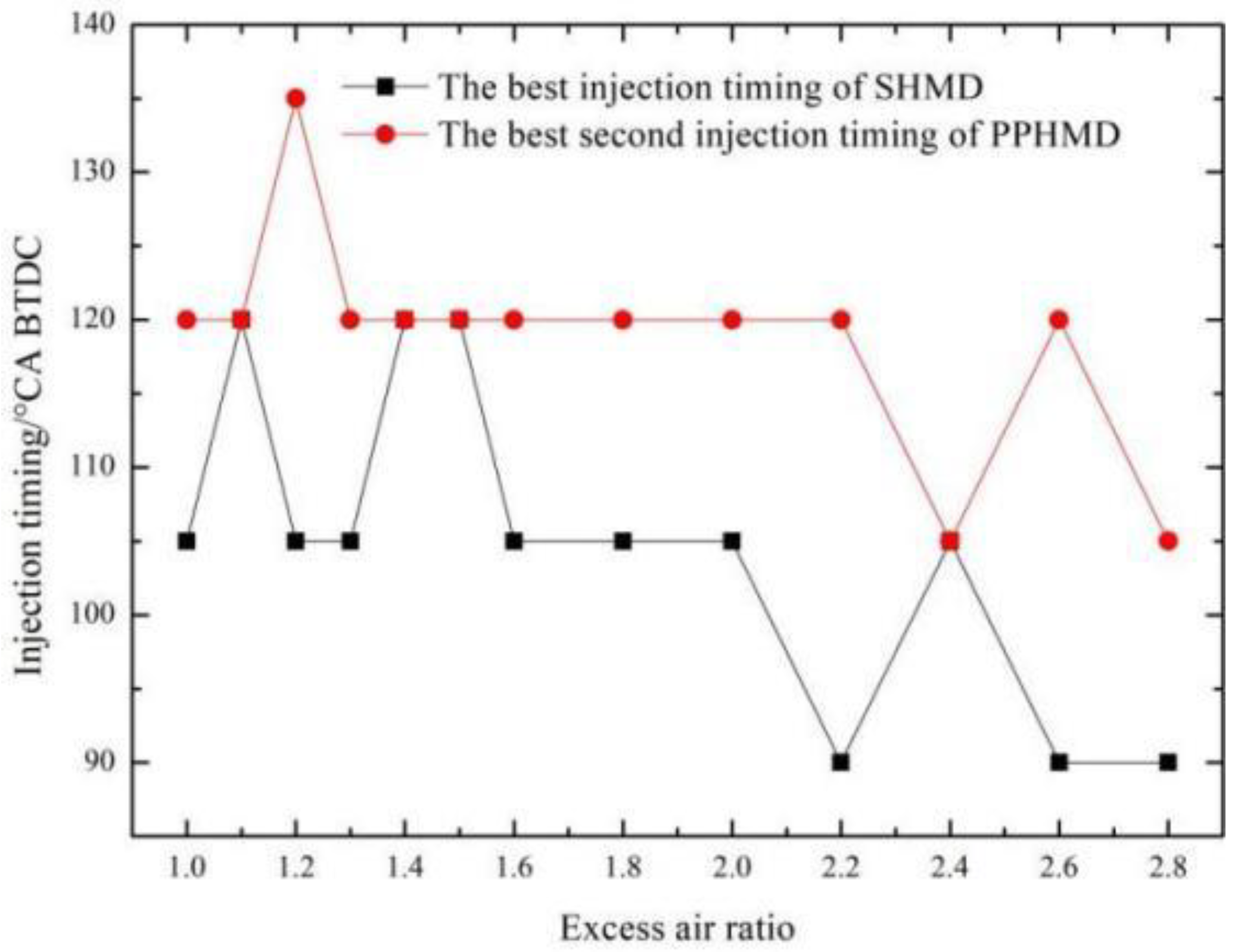


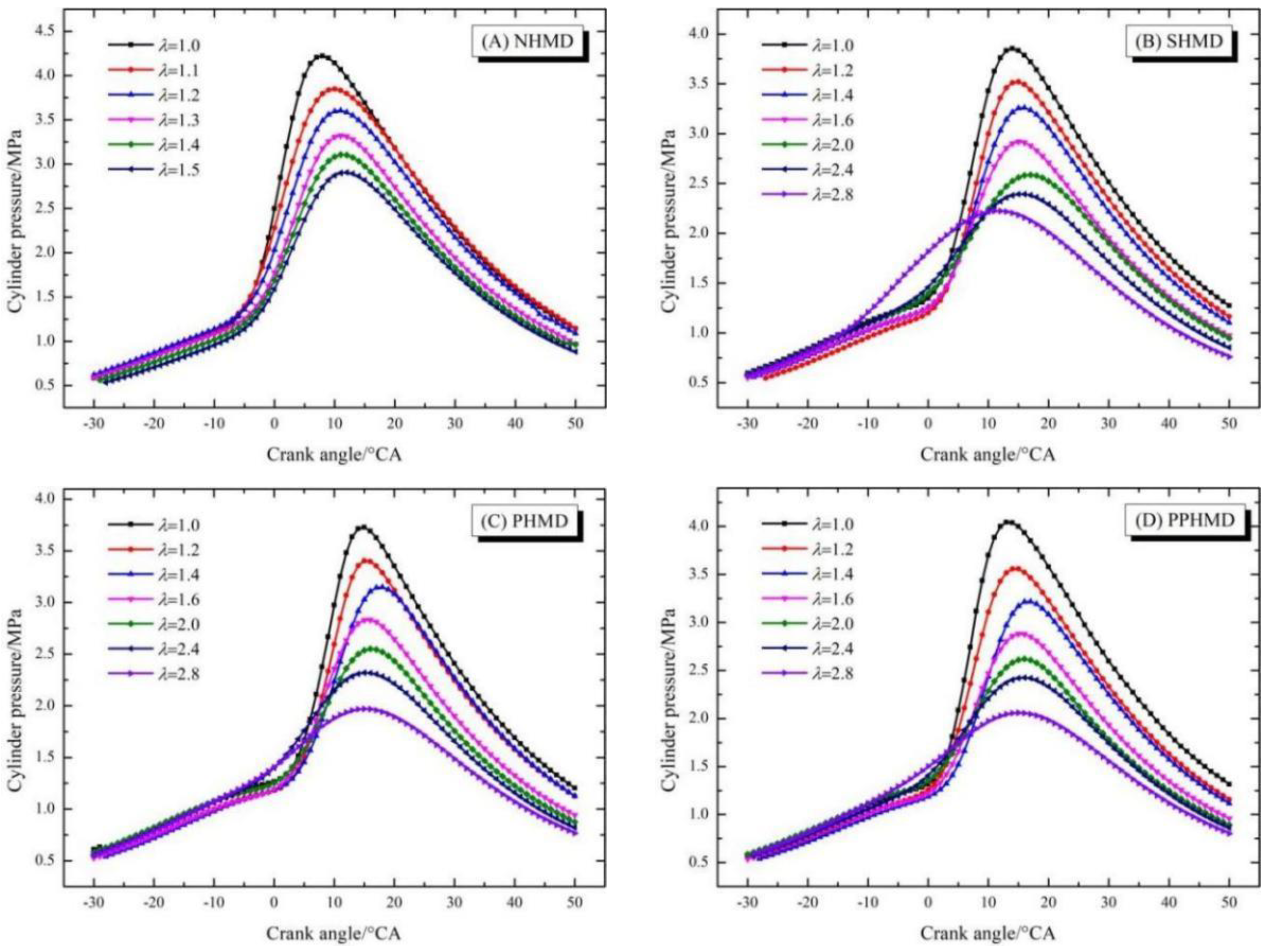
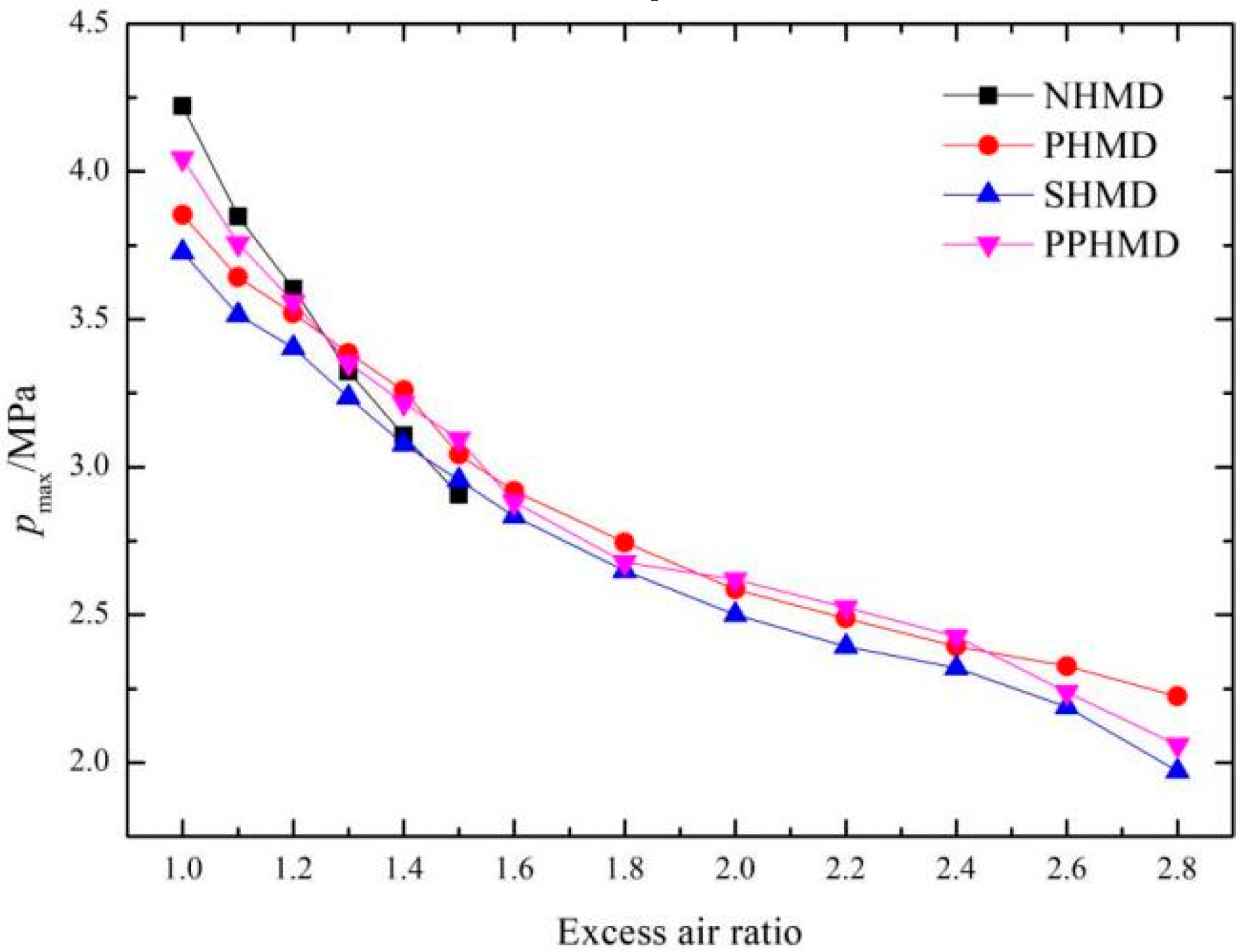
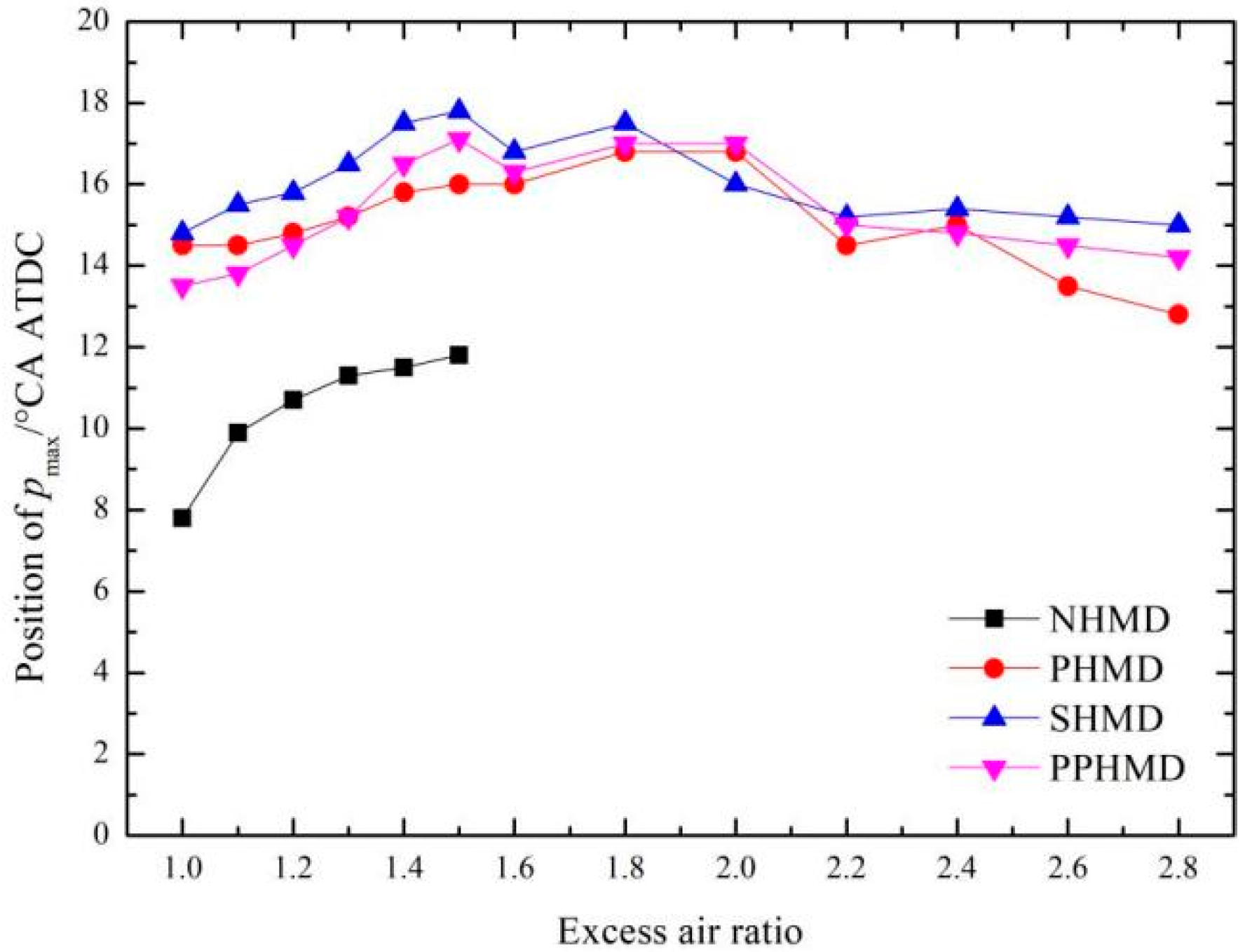
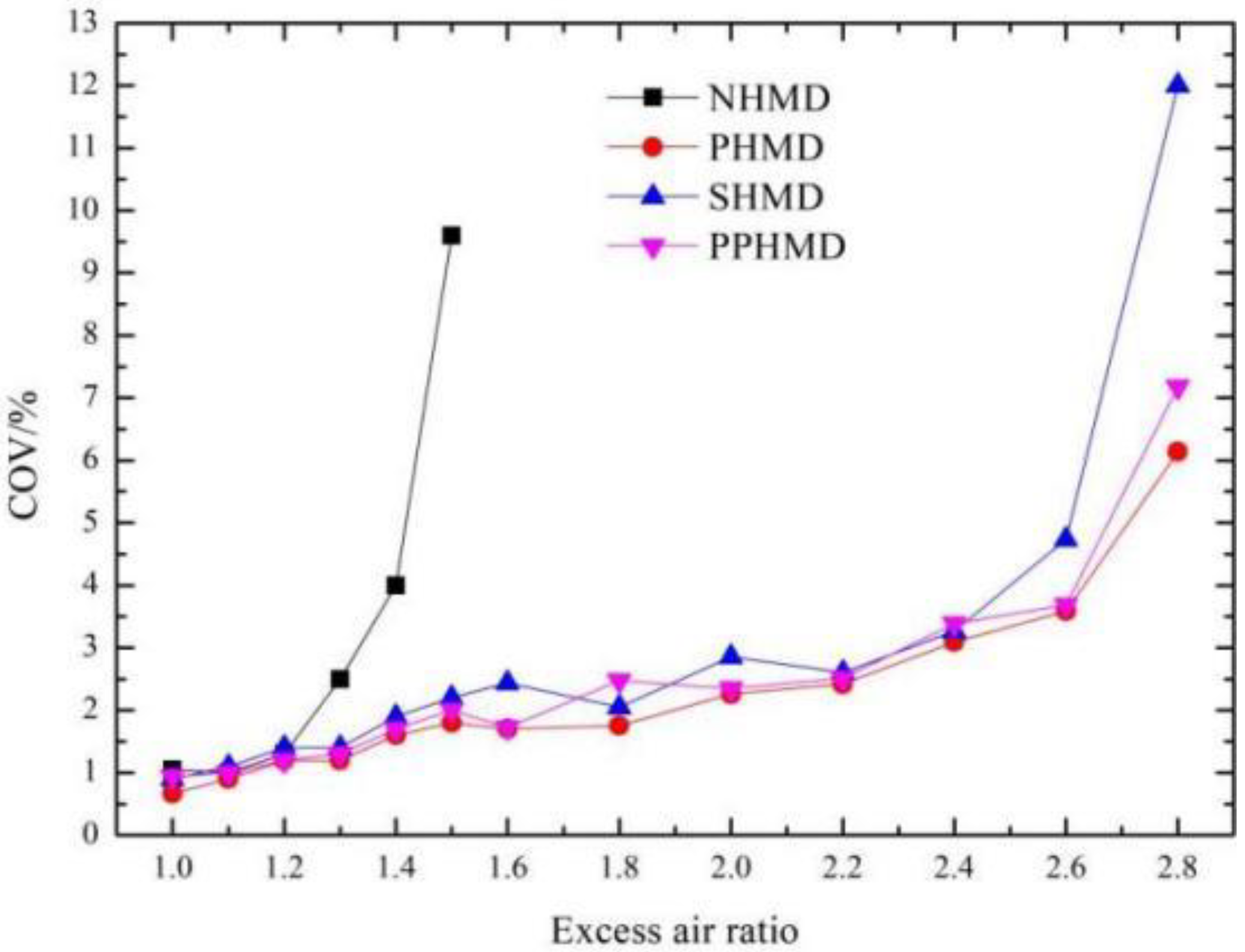


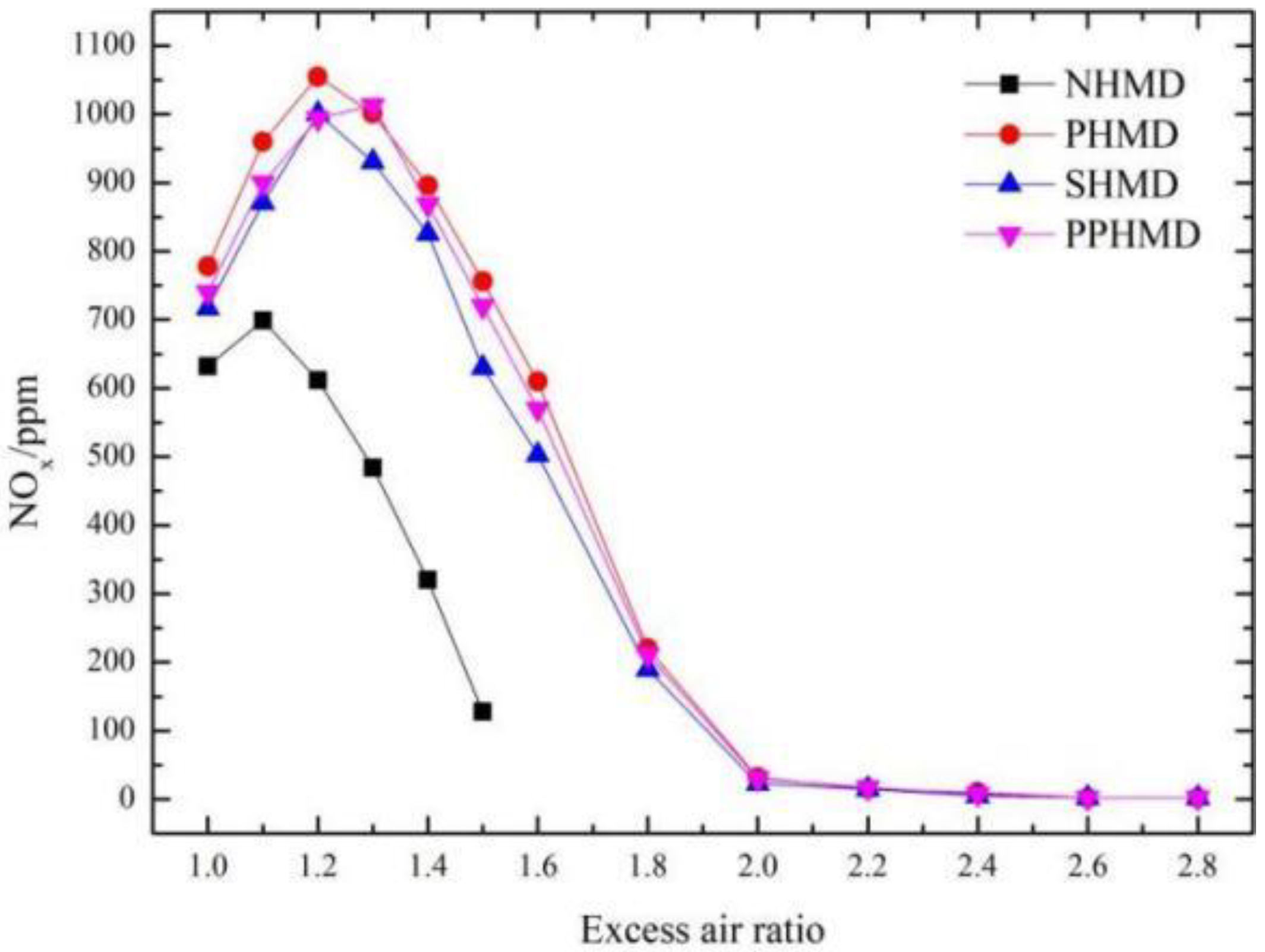
| Engine type | Four cylinders Naturally aspirated Spark ignition |
| Bore × stroke (mm) | 82.5 × 92.8 |
| Compression ratio | 9.6 |
| Displaced volume (L) | 2 |
| Item | Error | Measurement Instrument |
|---|---|---|
| Gasoline consumption | ≤±0.01 g/s | Ono Sokki DF−2420 |
| Crank angle (CA) position | ≤±0.01 °CA | Ono Sokki DS 9028 |
| Cylinder pressure | ≤±0.3 bar | Ono Sokki DS 9028 |
| Speed | ≤±1 rpm | CW160 |
| Brake power | ≤±0.4% | CW160 |
| Hydrogen consumption | ≤±0.2% | DMF−1−1AB |
| Emissions | ≤±0.1% | AVL DICOM 4000 |
| Excess air ratio | ≤±0.15 | LSU4.2 oxygen sensor |
| HMD | NHMD | SHMD | PHMD | PPHMD |
|---|---|---|---|---|
| Speed (r/min) | 1200 | |||
| Throttle opening (%) | 10 | |||
| Excess air ratio | 1 to 2.8 | |||
| Ignition timing (°CA BTDC) | Best | |||
| Hydrogen fraction | 0% | 20% | ||
| Direct injection pressure (MPa) | / | 5 | ||
| Second injection timing (°CA BTDC) | / | Best | / | Best |
| First injection proportion | / | / | / | Best |
| First injection timing (°CA BTDC) | / | / | 300 | 300 |
Publisher’s Note: MDPI stays neutral with regard to jurisdictional claims in published maps and institutional affiliations. |
© 2022 by the authors. Licensee MDPI, Basel, Switzerland. This article is an open access article distributed under the terms and conditions of the Creative Commons Attribution (CC BY) license (https://creativecommons.org/licenses/by/4.0/).
Share and Cite
Pan, S.; Wang, J.; Liang, B.; Duan, H.; Huang, Z. Experimental Study on the Effects of Hydrogen Injection Strategy on the Combustion and Emissions of a Hydrogen/Gasoline Dual Fuel SI Engine under Lean Burn Condition. Appl. Sci. 2022, 12, 10549. https://doi.org/10.3390/app122010549
Pan S, Wang J, Liang B, Duan H, Huang Z. Experimental Study on the Effects of Hydrogen Injection Strategy on the Combustion and Emissions of a Hydrogen/Gasoline Dual Fuel SI Engine under Lean Burn Condition. Applied Sciences. 2022; 12(20):10549. https://doi.org/10.3390/app122010549
Chicago/Turabian StylePan, Shiyi, Jinhua Wang, Bin Liang, Hao Duan, and Zuohua Huang. 2022. "Experimental Study on the Effects of Hydrogen Injection Strategy on the Combustion and Emissions of a Hydrogen/Gasoline Dual Fuel SI Engine under Lean Burn Condition" Applied Sciences 12, no. 20: 10549. https://doi.org/10.3390/app122010549
APA StylePan, S., Wang, J., Liang, B., Duan, H., & Huang, Z. (2022). Experimental Study on the Effects of Hydrogen Injection Strategy on the Combustion and Emissions of a Hydrogen/Gasoline Dual Fuel SI Engine under Lean Burn Condition. Applied Sciences, 12(20), 10549. https://doi.org/10.3390/app122010549






